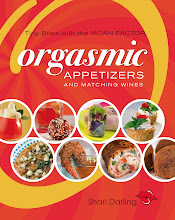 Recipe for tomato salad below.
Recipe for tomato salad below.It's time to enjoy a chilled glass of white wine on a blistering hot afternoon or balmy evening. I often recommend chilled white wines with high acidity for the summertime. Crisp, dry white wines with good acidity often have flavours reminiscent of lemons, limes, grapefruit, and gooseberries. Still others can have more grassy and mineral tones. Despite the flavours, the predominant taste sensation of crisp, dry white wines is zestiness or sourness from the wine's backbone of acidity. Give me a glass of Vinho Verde from Portugal any day of the week.
When recommending crisp, dry white wines, I often suggest Sauvignon Blanc and dry Riesling. Ontario's wineries produce outstanding dry Rieslings with what is describe as 'steely acidity.' However, there are other white wines produced in wine regions around the world that fall into this wine style category, too.
Pinot Bianco is an Italian grape variety grown in the northeast part of the country, in the provinces of Alto-Adige, Veneto and Friuli. Wines from this grape are medium-bodied with a light fruitiness and crisp acidity. They are sometimes fermented and/or aged in oak. When oak is employed these varieties fall into a different wine style category called big, fat whites. So, make sure that your pinot bianco has not seen any oak if you’re looking for a crisp, dry white.
Some Chardonnay are produced in this crisp, dry white wine style, as well. Chablis is the most northerly region of Burgundy. The area’s wines that receive the Chablis AOC must be made from the chardonnay grape. The AOC stands for the Code de Legislation des Appellation d’Origine Controlee. The AOC has two main objectives. The first is to geographically define wine-producing areas so that the origin of a wine may be clearly and accurately stated. The second objective is to establish production standards for each defined wine area, thus guaranteeing the origin and quality of a wine. The AOC is complemented by other laws, such as Vins Delimites de Qualite Superieure, Vin de Pays and Vin de Table. Generally speaking, an AOC wine is guaranteed to be of high quality, and to be produced in a way that preserves local traditions and emphasizes the uniqueness of the region or terroir. (Terroir is the combination of the geography, climate and soil of a particular wine region.)
Back to the crisp, dry white wine style. There are four classifications of Chablis AOC, each producing chardonnay with different character traits. All, however, falls into this crisp, white wine style. The classifications are: Petit Chablis, Chablis, Chablis Premier Cru and Chablis Grand Cru. This region also produces crisp, white wines from the Sauvignon Blanc and Aligote grapes.
In Bordeaux, Sauvignon Blanc is also grown and made into a crisp white with good acidity. Bairrada is a wine region in Portugal that produces white wines in this style, as well, with crispness and lemony character.
Other white wines that celebrate this style category are Bacchus and Baden from Germany, and a Swiss grape variety called Chasselas. Frascati, Pinot Grigio and Orvieto are three more crisp, dry whites from Italy. It’s not surprising that many dry, crisp whites come from Italy. Wines produced in this style are considered food friendly as the high acidity cleans the palate. The Italians are renowned for drinking wine with almost every meal. So, it’s not surprising that they would produce crisp, dry whites that clean the palate between bites.
Pinot Bianco is an Italian grape variety grown in the northeast part of the country, in the provinces of Alto-Adige, Veneto and Friuli. Wines from this grape are medium-bodied with a light fruitiness and crisp acidity. They are sometimes fermented and/or aged in oak. When oak is employed these varieties fall into a different wine style category called big, fat whites. So, make sure that your pinot bianco has not seen any oak if you’re looking for a crisp, dry white.
Some Chardonnay are produced in this crisp, dry white wine style, as well. Chablis is the most northerly region of Burgundy. The area’s wines that receive the Chablis AOC must be made from the chardonnay grape. The AOC stands for the Code de Legislation des Appellation d’Origine Controlee. The AOC has two main objectives. The first is to geographically define wine-producing areas so that the origin of a wine may be clearly and accurately stated. The second objective is to establish production standards for each defined wine area, thus guaranteeing the origin and quality of a wine. The AOC is complemented by other laws, such as Vins Delimites de Qualite Superieure, Vin de Pays and Vin de Table. Generally speaking, an AOC wine is guaranteed to be of high quality, and to be produced in a way that preserves local traditions and emphasizes the uniqueness of the region or terroir. (Terroir is the combination of the geography, climate and soil of a particular wine region.)
Back to the crisp, dry white wine style. There are four classifications of Chablis AOC, each producing chardonnay with different character traits. All, however, falls into this crisp, white wine style. The classifications are: Petit Chablis, Chablis, Chablis Premier Cru and Chablis Grand Cru. This region also produces crisp, white wines from the Sauvignon Blanc and Aligote grapes.
In Bordeaux, Sauvignon Blanc is also grown and made into a crisp white with good acidity. Bairrada is a wine region in Portugal that produces white wines in this style, as well, with crispness and lemony character.
Other white wines that celebrate this style category are Bacchus and Baden from Germany, and a Swiss grape variety called Chasselas. Frascati, Pinot Grigio and Orvieto are three more crisp, dry whites from Italy. It’s not surprising that many dry, crisp whites come from Italy. Wines produced in this style are considered food friendly as the high acidity cleans the palate. The Italians are renowned for drinking wine with almost every meal. So, it’s not surprising that they would produce crisp, dry whites that clean the palate between bites.
When pairing foods to crisp, dry white wines, consider the acidity first. This acidity complements the same taste sensation in foods and also nicely offsets saltiness. Make sure, however, that the acid in the wine is greater than the one in the food. Vinaigrettes can work or clash with crisp, dry whites, depending on the type of vinegar used. Cider and white vinegar clash. They are simply too acidic to pair with wine. White balsamic and rice vinegar harmonize extremely well with crisp, dry whites. Dark balsamic may or may not work, depending on its level of sweetness. Go for the more sour versions to work with this wine. A fresh tomato salad with sweet onions, fresh basil and fresh grapefruit mint drizzled in white balsamic is a favourite summer salad of mine that I partner to New Zealand Sauvignon Blanc. The acidity in the wine and salad create harmony on the palate.
Pair the zesty quality in other foods, such as yoghurt, feta, goat cheese, and lemons with crisp, dry whites. Light bodied fish, such as filet of sole, drizzled in fresh lemon juice when partnered to a crisp, dry white will make even your finicky guests moan in delight. This style of wine also complements salty foods, such as caviar, smoked salmon, and oysters on the half shell. And, of course, cheese! Parmesan, due to its saltiness, has a natural affinity to crisp, dry whites. Try Portugal's Vinho Verde with asparagus wrapped in prosciutto and grilled on the barbie and a white bean dip with parmesan and roasted garlic as the starters to a summertime meal.
even your finicky guests moan in delight. This style of wine also complements salty foods, such as caviar, smoked salmon, and oysters on the half shell. And, of course, cheese! Parmesan, due to its saltiness, has a natural affinity to crisp, dry whites. Try Portugal's Vinho Verde with asparagus wrapped in prosciutto and grilled on the barbie and a white bean dip with parmesan and roasted garlic as the starters to a summertime meal.
 even your finicky guests moan in delight. This style of wine also complements salty foods, such as caviar, smoked salmon, and oysters on the half shell. And, of course, cheese! Parmesan, due to its saltiness, has a natural affinity to crisp, dry whites. Try Portugal's Vinho Verde with asparagus wrapped in prosciutto and grilled on the barbie and a white bean dip with parmesan and roasted garlic as the starters to a summertime meal.
even your finicky guests moan in delight. This style of wine also complements salty foods, such as caviar, smoked salmon, and oysters on the half shell. And, of course, cheese! Parmesan, due to its saltiness, has a natural affinity to crisp, dry whites. Try Portugal's Vinho Verde with asparagus wrapped in prosciutto and grilled on the barbie and a white bean dip with parmesan and roasted garlic as the starters to a summertime meal.Crisp, dry whites sometimes have a pleasant bitterness on the finish that works with the bitterness in spinach, raddichio, and toasted walnuts, as well.
Another simple appetizer that pairs with this style of wine is baked feta. Place a chunk of fresh feta in the centre of a large piece of foil wrap. Drizzle with olive oil and sprinkle with slices of black olives and finely chopped fresh oregano. Seal up the foil and place the feta in the oven at 350 F for 15 minutes. When heated the feta melts with a dip-like consistency. Transfer your feta dip to a bowl and serve with flat bread, accompanied by a bottle of Ontario dry Riesling. Heaven!





No comments:
Post a Comment